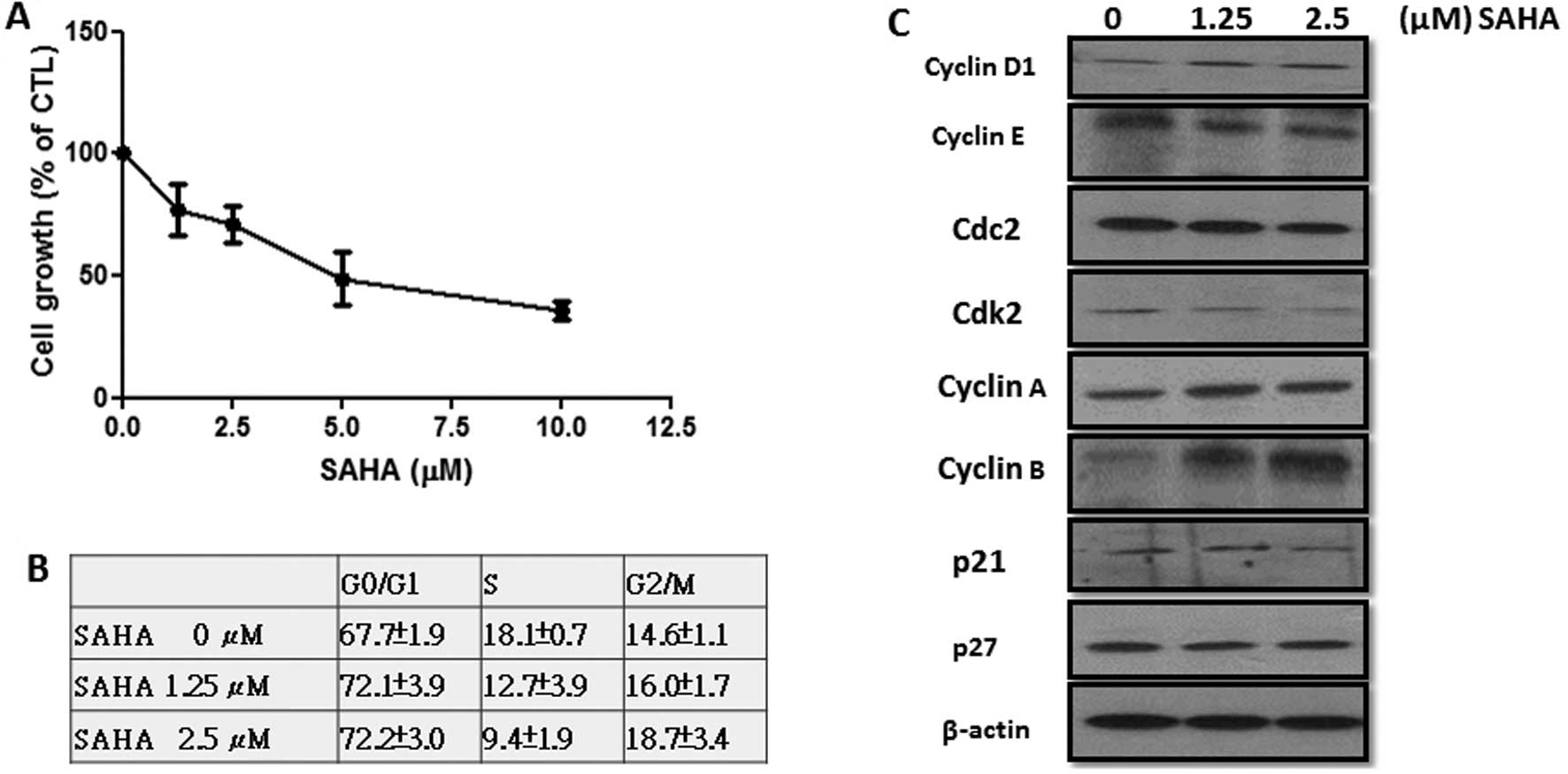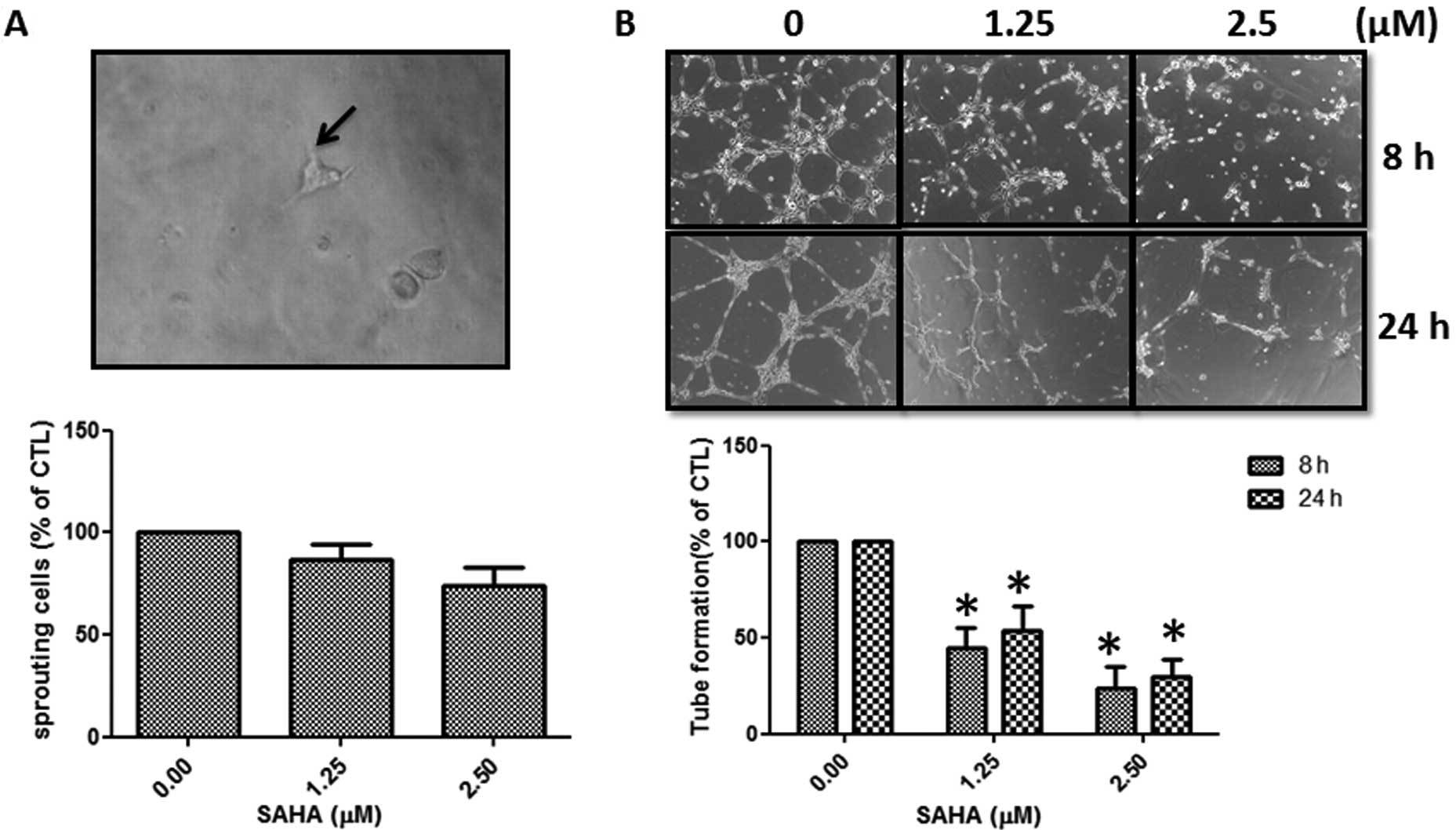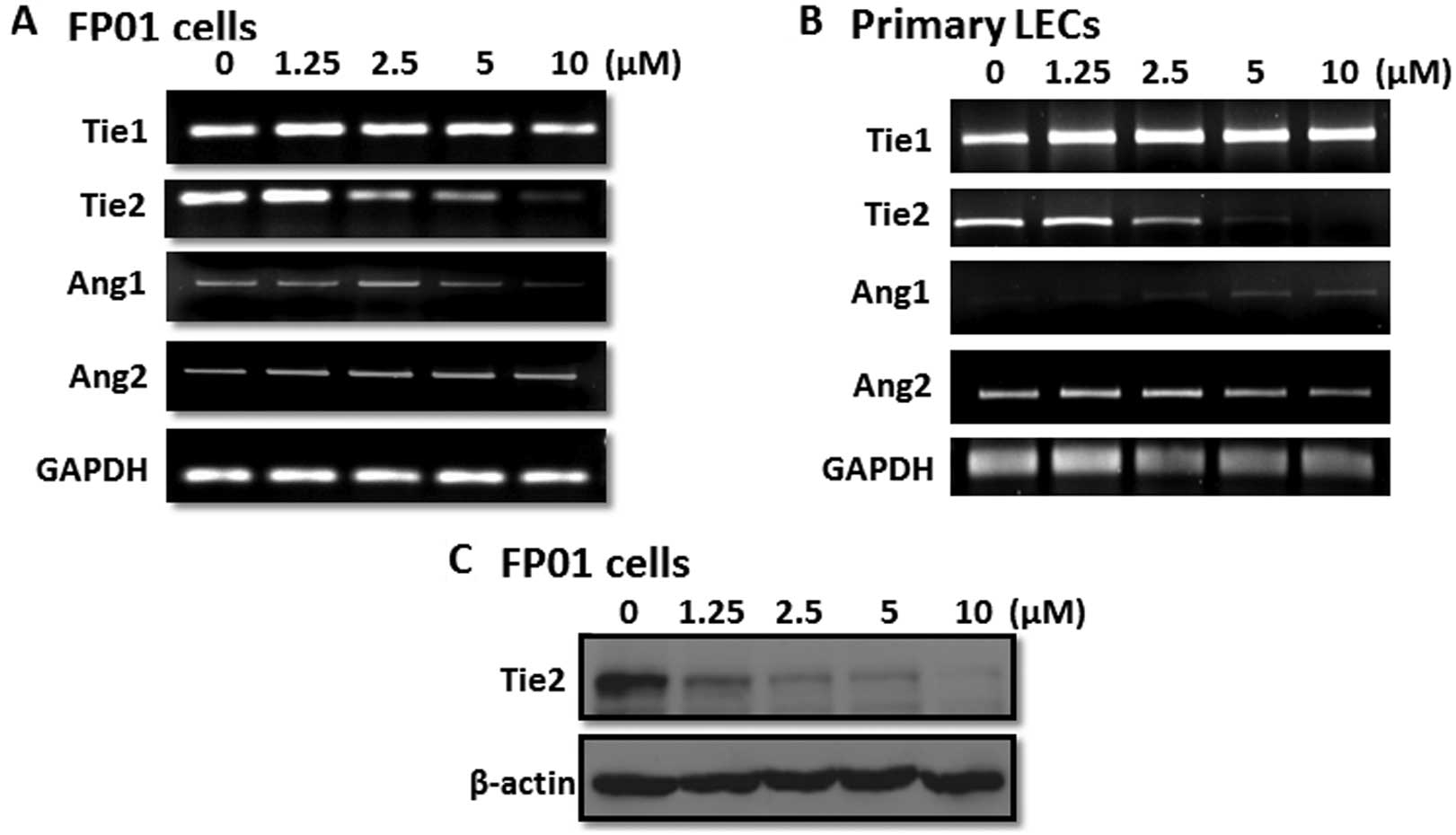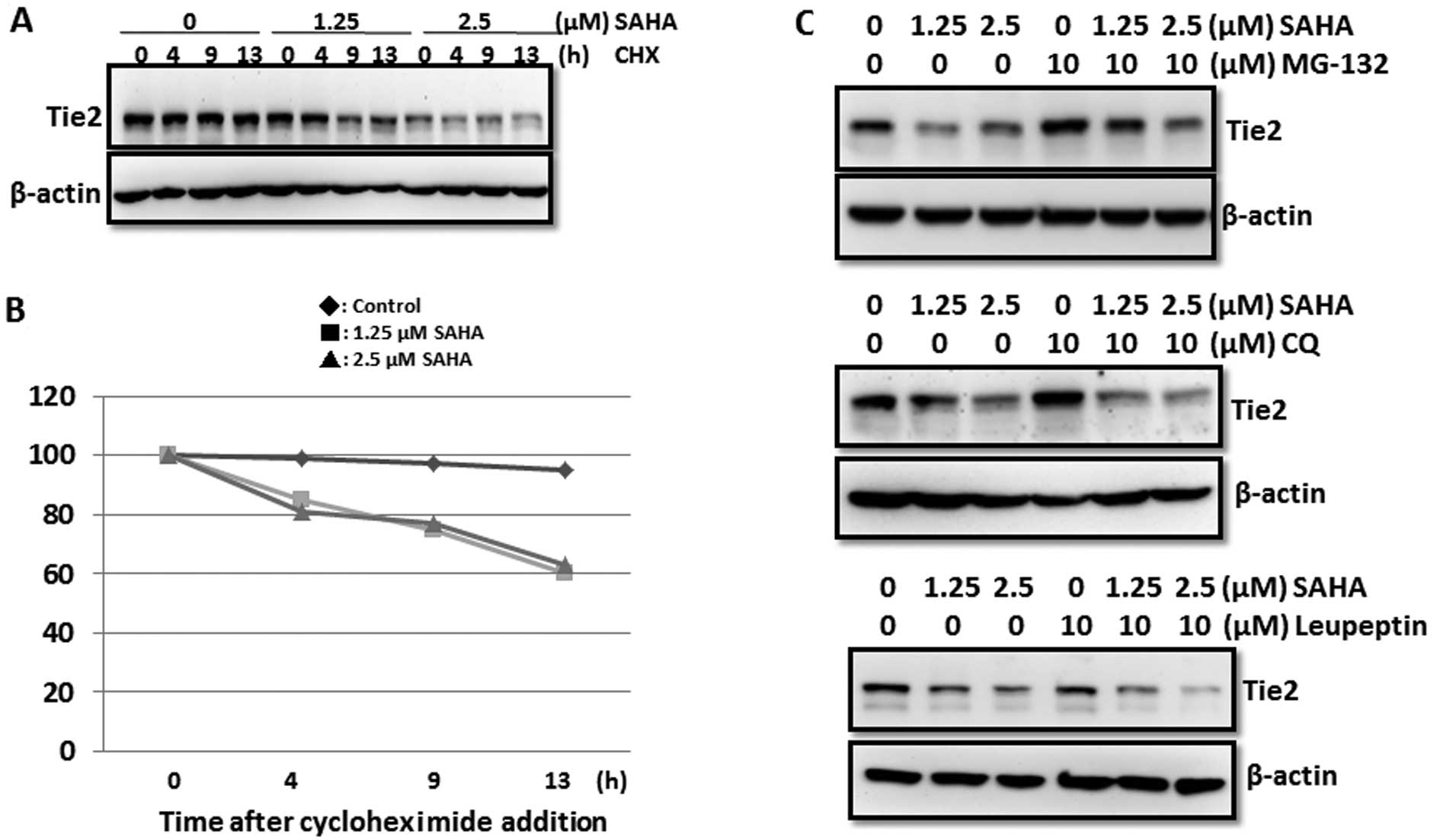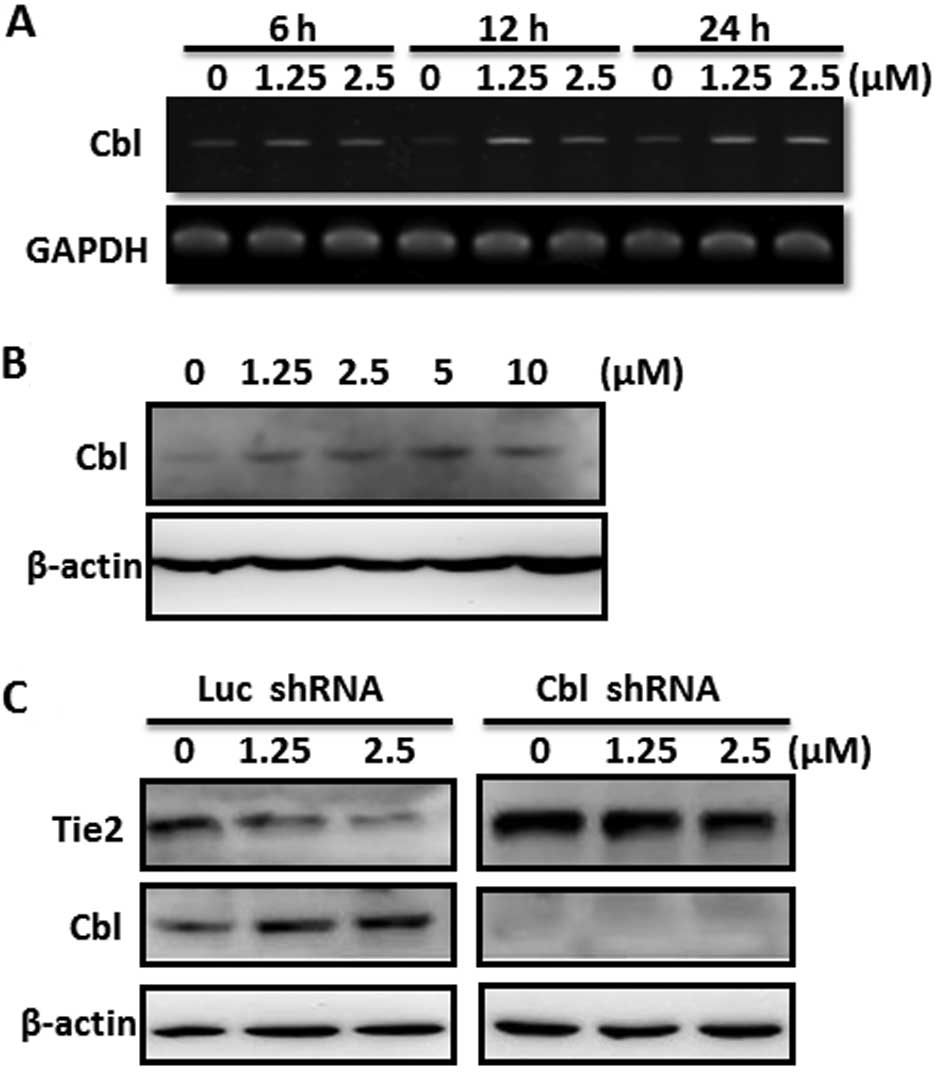|
1
|
Minucci S and Pelicci PG: Histone
deacetylase inhibitors and the promise of epigenetic (and more)
treatments for cancer. Nat Rev Cancer. 6:38–51. 2006. View Article : Google Scholar : PubMed/NCBI
|
|
2
|
Inche AG and La Thangue NB: Chromatin
control and cancer-drug discovery: realizing the promise. Drug
Discov Today. 11:97–109. 2006. View Article : Google Scholar : PubMed/NCBI
|
|
3
|
Olsen EA, Kim YH, Kuzel TM, et al: Phase
IIb multicenter trial of vorinostat in patients with persistent,
progressive, or treatment refractory cutaneous T-cell lymphoma. J
Clin Oncol. 25:3109–3115. 2007. View Article : Google Scholar : PubMed/NCBI
|
|
4
|
Duvic M and Vu J: Vorinostat: a new oral
histone deacetylase inhibitor approved for cutaneous T-cell
lymphoma. Expert Opin Investig Drugs. 16:1111–1120. 2007.
View Article : Google Scholar : PubMed/NCBI
|
|
5
|
Emanuele S, Lauricella M and Tesoriere G:
Histone deacetylase inhibitors: apoptotic effects and clinical
implications (Review). Int J Oncol. 33:637–646. 2008.PubMed/NCBI
|
|
6
|
Zhao Y, Tan J, Zhuang L, et al: Inhibitors
of histone deacetylases target the Rb-E2F1 pathway for apoptosis
induction through activation of proapoptotic protein Bim. Proc Natl
Acad Sci USA. 102:16090–16095. 2005. View Article : Google Scholar : PubMed/NCBI
|
|
7
|
Gui CY, Ngo L, Xu WS, et al: Histone
deacetylase (HDAC) inhibitor activation of p21WAF1
involves changes in promoter-associated proteins, including HDAC1.
Proc Natl Acad Sci USA. 101:1241–1246. 2004. View Article : Google Scholar : PubMed/NCBI
|
|
8
|
Richon VM, Sandhoff TW, Rifkind RA and
Marks PA: Histone deacetylase inhibitor selectively induces
p21WAF1 expression and gene-associated histone
acetylation. Proc Natl Acad Sci USA. 97:10014–10019. 2000.
View Article : Google Scholar : PubMed/NCBI
|
|
9
|
Woan KV, Sahakian E, Sotomayor EM, Seto E
and Villagra A: Modulation of antigen-presenting cells by HDAC
inhibitors: implications in autoimmunity and cancer. Immunol Cell
Biol. 90:55–65. 2012. View Article : Google Scholar : PubMed/NCBI
|
|
10
|
Blanchard F and Chipoy C: Histone
deacetylase inhibitors: new drugs for the treatment of inflammatory
diseases? Drug Discov Today. 10:197–204. 2005. View Article : Google Scholar : PubMed/NCBI
|
|
11
|
Deroanne CF, Bonjean K, Servotte S, et al:
Histone deacetylases inhibitors as anti-angiogenic agents altering
vascular endothelial growth factor signaling. Oncogene. 21:427–436.
2002. View Article : Google Scholar : PubMed/NCBI
|
|
12
|
Alitalo K: The lymphatic vasculature in
disease. Nat Med. 17:1371–1380. 2011. View
Article : Google Scholar : PubMed/NCBI
|
|
13
|
Achen MG, McColl BK and Stacker SA: Focus
on lymphangiogenesis in tumor metastasis. Cancer Cell. 7:121–127.
2005. View Article : Google Scholar : PubMed/NCBI
|
|
14
|
Cao R, Björndahl MA, Religa P, et al:
PDGF-BB induces intratumoral lymphangiogenesis and promotes
lymphatic metastasis. Cancer Cell. 6:333–345. 2004. View Article : Google Scholar : PubMed/NCBI
|
|
15
|
Augustin HG, Koh GY, Thurston G and
Alitalo K: Control of vascular morphogenesis and homeostasis
through the angiopoietin-Tie system. Nat Rev Mol Cell Biol.
10:165–177. 2009. View
Article : Google Scholar : PubMed/NCBI
|
|
16
|
Maisonpierre PC, Suri C, Jones PF, et al:
Angiopoietin-2, a natural antagonist for Tie2 that disrupts in vivo
angiogenesis. Science. 277:55–60. 1997. View Article : Google Scholar : PubMed/NCBI
|
|
17
|
Yuan HT, Khankin EV, Karumanchi SA and
Parikh SM: Angiopoietin 2 is a partial agonist/antagonist of Tie2
signaling in the endothelium. Mol Cell Biol. 29:2011–2022. 2009.
View Article : Google Scholar : PubMed/NCBI
|
|
18
|
Kim I, Kim JH, Moon SO, Kwak HJ, Kim NG
and Koh GY: Angiopoietin-2 at high concentration can enhance
endothelial cell survival through the phosphatidylinositol
3′-kinase/Akt signal transduction pathway. Oncogene. 19:4549–4552.
2000.PubMed/NCBI
|
|
19
|
Murray BW, Padrique ES, Pinko C and
McTigue MA: Mechanistic effects of autophosphorylation on receptor
tyrosine kinase catalysis: enzymatic characterization of Tie2 and
phospho-Tie2. Biochemistry. 40:10243–10253. 2001. View Article : Google Scholar : PubMed/NCBI
|
|
20
|
Jones N, Chen SH, Sturk C, Master Z, Tran
J, Kerbel RS and Dumont DJ: A unique autophosphorylation site on
Tie2/Tek mediates Dok-R phosphotyrosine binding domain binding and
function. Mol Cell Biol. 23:2658–2668. 2003. View Article : Google Scholar : PubMed/NCBI
|
|
21
|
Jones N, Master Z, Jones J, Bouchard D,
Gunji Y, Sasaki H, Daly R, Alitalo K and Dumont DJ: Identification
of Tek/Tie2 binding partners. Binding to a multifunctional docking
site mediates cell survival and migration. J Biol Chem.
274:30896–30905. 1999. View Article : Google Scholar : PubMed/NCBI
|
|
22
|
Dellinger M, Hunter R, Bernas M, Gale N,
Yancopoulos G, Erickson R and Witte M: Defective remodeling and
maturation of the lymphatic vasculature in Angiopoietin-2 deficient
mice. Dev Biol. 319:309–320. 2008. View Article : Google Scholar : PubMed/NCBI
|
|
23
|
Shimoda H, Bernas MJ, Witte MH, Gale NW,
Yancopoulos GD and Kato S: Abnormal recruitment of periendothelial
cells to lymphatic capillaries in digestive organs of
angiopoietin-2-deficient mice. Cell Tissue Res. 328:329–337. 2007.
View Article : Google Scholar : PubMed/NCBI
|
|
24
|
Kajiya K, Kidoya H, Sawane M,
Matsumoto-Okazaki Y, Yamanishi H, Furuse M and Takakura N:
Promotion of lymphatic integrity by angiopoietin-1/Tie2 signaling
during inflammation. Am J Pathol. 180:1273–1282. 2012. View Article : Google Scholar : PubMed/NCBI
|
|
25
|
Pan MR, Chang TM, Chang HC, Su JL, Wang HW
and Hung WC: Sumoylation of Prox1 controls its ability to induce
VEGFR3 expression and lymphatic phenotypes in endothelial cells. J
Cell Sci. 122:3358–3364. 2009. View Article : Google Scholar : PubMed/NCBI
|
|
26
|
Wehrle C, Van Slyke P and Dumont DJ:
Angiopoietin-1-induced ubiquitylation of Tie2 by c-Cbl is required
for internalization and degradation. Biochem J. 423:375–380. 2009.
View Article : Google Scholar : PubMed/NCBI
|
|
27
|
Deroanne CF, Bonjean K, Servotte S, et al:
Histone deacetylases inhibitors as anti-angiogenic agents altering
vascular endothelial growth factor signaling. Oncogene. 21:427–436.
2002. View Article : Google Scholar : PubMed/NCBI
|
|
28
|
Ugur HC, Ramakrishna N, Bello L, et al:
Continuous intracranial administration of suberoylanilide
hydroxamic acid (SAHA) inhibits tumor growth in an orthotopic
glioma model. J Neurooncol. 83:267–275. 2007. View Article : Google Scholar : PubMed/NCBI
|
|
29
|
Mühlethaler-Mottet A, Meier R, Flahaut M,
et al: Complex molecular mechanisms cooperate to mediate histone
deacetylase inhibitors anti-tumour activity in neuroblastoma cells.
Mol Cancer. 7:552008.PubMed/NCBI
|
|
30
|
Chou CW and Chen CC: HDAC inhibition
upregulates the expression of angiostatic ADAMTS1. FEBS Lett.
582:4059–4065. 2008. View Article : Google Scholar : PubMed/NCBI
|
|
31
|
Cheng HT and Hung WC: Inhibition of
lymphangiogenic factor VEGF-C expression and production by the
histone deacetylase inhibitor suberoylanilide hydroxamic acid in
breast cancer cells. Oncol Rep. 29:1238–1244. 2013.
|
|
32
|
Huang H, Bhat A, Woodnutt G and Lappe R:
Targeting the ANGPT-TIE2 pathway in malignancy. Nat Rev Cancer.
10:575–585. 2010. View
Article : Google Scholar : PubMed/NCBI
|
|
33
|
Oliner J, Min H, Leal J, et al:
Suppression of angiogenesis and tumor growth by selective
inhibition of angiopoietin-2. Cancer Cell. 6:507–516. 2004.
View Article : Google Scholar : PubMed/NCBI
|
|
34
|
Shimamoto G, Gegg C, Boone T and Quéva C:
Peptibodies: A flexible alternative format to antibodies. MAbs.
4:586–591. 2012. View Article : Google Scholar : PubMed/NCBI
|
|
35
|
Beck A and Reichert JM: Therapeutic
Fc-fusion proteins and peptides as successful alternatives to
antibodies. MAbs. 3:415–416. 2011. View Article : Google Scholar : PubMed/NCBI
|
|
36
|
Herbst RS, Hong D, Chap L, et al: Safety,
pharmacokinetics and antitumor activity of AMG 386, a selective
angiopoietin inhibitor, in adult patients with advanced solid
tumors. J Clin Oncol. 27:3557–3565. 2009. View Article : Google Scholar : PubMed/NCBI
|















